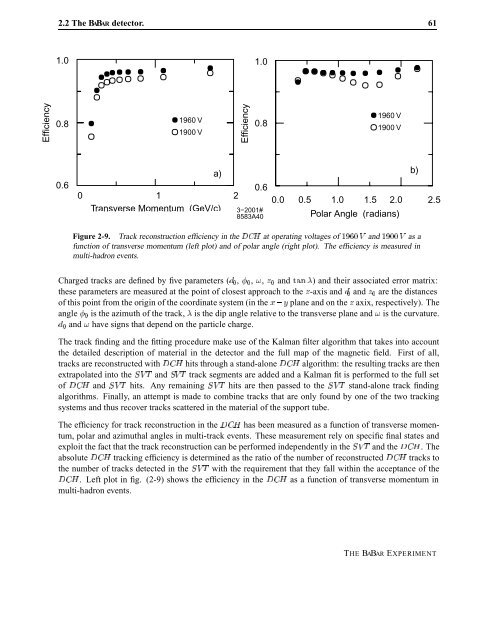Violation in Mixing
Violation in Mixing
Violation in Mixing
Create successful ePaper yourself
Turn your PDF publications into a flip-book with our unique Google optimized e-Paper software.
Efficiency<br />
2.2 The BABAR detector. 61<br />
1.0<br />
0.8<br />
0.6<br />
1960 V<br />
1900 V<br />
0 1<br />
Transverse Momentum (GeV/c)<br />
2<br />
a)<br />
Efficiency<br />
1.0<br />
0.8<br />
3−2001#<br />
8583A40<br />
1960 V<br />
1900 V<br />
0.6<br />
0.0 0.5 1.0 1.5 2.0 2.5<br />
Polar Angle (radians)<br />
Figure 2-9. Track reconstruction efficiency <strong>in</strong> the ��À at operat<strong>in</strong>g voltages of �� Î and � Î as a<br />
function of transverse momentum (left plot) and of polar angle (right plot). The efficiency is measured <strong>in</strong><br />
multi-hadron events.<br />
Charged tracks are def<strong>in</strong>ed by five parameters (� , � , �, Þ and Ø�Ò �) and their associated error matrix:<br />
these parameters are measured at the po<strong>in</strong>t of closest approach to the Þ-axis and � and Þ are the distances<br />
of this po<strong>in</strong>t from the orig<strong>in</strong> of the coord<strong>in</strong>ate system (<strong>in</strong> the Ü Ý plane and on the Þ axix, respectively). The<br />
angle � is the azimuth of the track, � is the dip angle relative to the transverse plane and � is the curvature.<br />
� and � have signs that depend on the particle charge.<br />
The track f<strong>in</strong>d<strong>in</strong>g and the fitt<strong>in</strong>g procedure make use of the Kalman filter algorithm that takes <strong>in</strong>to account<br />
the detailed description of material <strong>in</strong> the detector and the full map of the magnetic field. First of all,<br />
tracks are reconstructed with ��À hits through a stand-alone ��À algorithm: the result<strong>in</strong>g tracks are then<br />
extrapolated <strong>in</strong>to the ËÎÌ and ËÎÌ track segments are added and a Kalman fit is performed to the full set<br />
of ��À and ËÎÌ hits. Any rema<strong>in</strong><strong>in</strong>g ËÎÌ hits are then passed to the ËÎÌ stand-alone track f<strong>in</strong>d<strong>in</strong>g<br />
algorithms. F<strong>in</strong>ally, an attempt is made to comb<strong>in</strong>e tracks that are only found by one of the two track<strong>in</strong>g<br />
systems and thus recover tracks scattered <strong>in</strong> the material of the support tube.<br />
The efficiency for track reconstruction <strong>in</strong> the ��À has been measured as a function of transverse momentum,<br />
polar and azimuthal angles <strong>in</strong> multi-track events. These measurement rely on specific f<strong>in</strong>al states and<br />
exploit the fact that the track reconstruction can be performed <strong>in</strong>dependently <strong>in</strong> the ËÎÌ and the ��À. The<br />
absolute ��À track<strong>in</strong>g efficiency is determ<strong>in</strong>ed as the ratio of the number of reconstructed ��À tracks to<br />
the number of tracks detected <strong>in</strong> the ËÎÌ with the requirement that they fall with<strong>in</strong> the acceptance of the<br />
��À. Left plot <strong>in</strong> fig. (2-9) shows the efficiency <strong>in</strong> the ��À as a function of transverse momentum <strong>in</strong><br />
multi-hadron events.<br />
b)<br />
THE BABAR EXPERIMENT















